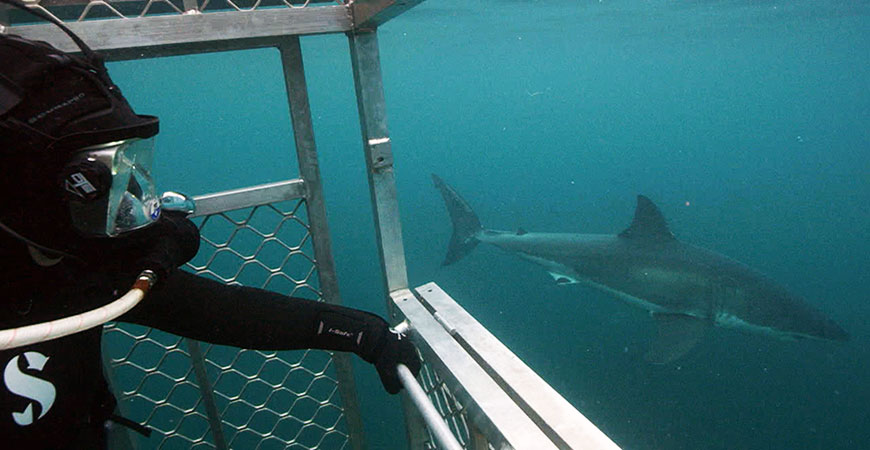
UC Merced's resident shark expert, Professor Sora Kim, will be featured on the prime-time, premiere-night episode of Discovery’s Shark Week discussing an enormous, legendary sea creature that takes on different forms in different cultures but has a basis in science.
At 9 p.m. EDT Sunday, audiences all over the world can watch Kim as she dives with great white sharks off the southern coast of New Zealand for the episode titled “Jaws vs Leviathan.”
Leviathan, a mythological sea monster, has been drawn in various forms throughout the ages, and referenced in such books as the Bible and “Moby Dick.” Most often, it is represented as a serpent or dragon, although some scientists and artists depicted leviathan as just an enormous whale.
In truth, livyatan, or leviathan as it has been dubbed, is a relative of the modern sperm whale, first identified through fossils found in southern Peru. It lived about 12 million to 13 million years ago and became extinct about 5 million years ago, meaning that at one point it existed with megalodon and might have competed for similar food.
Leviathan was comparable in size to the 50-foot-plus megalodon and modern sperm whales, which can be up to 52 feet long with 4- to 8-inch teeth.
Leviathan was something like the modern-day orca, but much larger, with much larger teeth and more bite force, given its 3 meter-long head, Kim said.
 Kim is a shark ecologist who studies the animals through the isotopes found in tissue samples, but she is especially interested in shark teeth, as they are preserved in the fossil record. Her research program focuses on connecting extinct and modern animals using preserved chemistry.
Kim is a shark ecologist who studies the animals through the isotopes found in tissue samples, but she is especially interested in shark teeth, as they are preserved in the fossil record. Her research program focuses on connecting extinct and modern animals using preserved chemistry.
Although she has been scuba diving and snorkeling and has seen sharks in the wild, this is the first time in her career she has cage-dived with them.
“It was beautiful and surreal,” she said. “I was struck by how curious and agile they are and how fast they can move. They would come in really fast and turn so quickly to swim past the cage. Sometimes you would see them at what seemed like a distance away and suddenly they would be there in front of you.”
She said she observed the animals’ spatial awareness not only of the cages and boat but of each other, and how they interacted and almost acknowledged each other, showing respect for the larger sharks.
On Kim’s first dive, she was accompanied by shark expert and conservationist Tristan Gutteridge, who is often featured in television shows that focus on sharks. She worked with him for Shark Week last year, too, and the time they spent together this year allowed them to talk more about science and potential scientific collaborations.
“I don't know if this will make it into the episode, but it was really great to have an opportunity for a real scientific discussion with Dr. Gutteridge as well as Odette Howarth and Kina Scollay, two other shark experts featured on the show,” Kim said.
Hazmat Productions, the company that makes shows with a “Jaws vs.” theme each year, flew Kim to New Zealand’s Stewart Island over UC Merced’s spring break to film the episode, including the cage dives.
Stewart Island is the closest to Antarctica she has ever been, though many of the shark-tooth fossils she uses in her research come from the Antarctic region and she has a research project based there.
That was among the reasons she wanted to participate, Kim said. It was also important to her to be part of diversifying ocean science by representing women and those often underrepresented in sciences. Diversity is a theme that has carried over into the summer, as she leads a workshop this month in partnership with the Monterey Bay Aquarium and Minorities in Shark Science.




